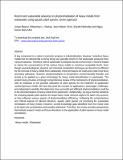| dc.description.abstract | A key component in a nation's economic progress is industrialization, however, hazardous heavy metals that are detrimental to living things are typically present in the wastewater produced from various industries. Therefore, before wastewater is released into the environment, it must be treated to reduce the concentrations of the various heavy metals to maximum acceptable levels. Even though several biological, physical, and chemical remediation techniques are found to be efficient for the removal of heavy metals from wastewater, these techniques are costly and create more toxic secondary pollutants. However, phytoremediation is inexpensive, environmentally friendly, and simple to be applied as a green technology for heavy metal detoxification in wastewater. The present study provides a thorough comprehensive review of the mechanisms of phytoremediation, with an emphasis on the possible utilization of plant species for the treatment of wastewater containing heavy metals. We have discussed the concept, its applications, advantages, challenges, and independent variables that determine how successful and efficient phytoremediation could be in the decontamination of heavy metals from wastewater. Additionally, we argue that the standards for choosing aquatic plant species for target heavy metal removal ought to be taken into account, as they influence various aspects of phytoremediation efficiency. Following the comprehensive and critical analysis of relevant literature, aquatic plant species are promising for sustainable remediation of heavy metals. However, several knowledge gaps identified from the review need to be taken into consideration and possibly addressed. Therefore, the review provides perspectives that indicate research needs and future directions on the application of plant species in heavy metal remediation. | en_US |

